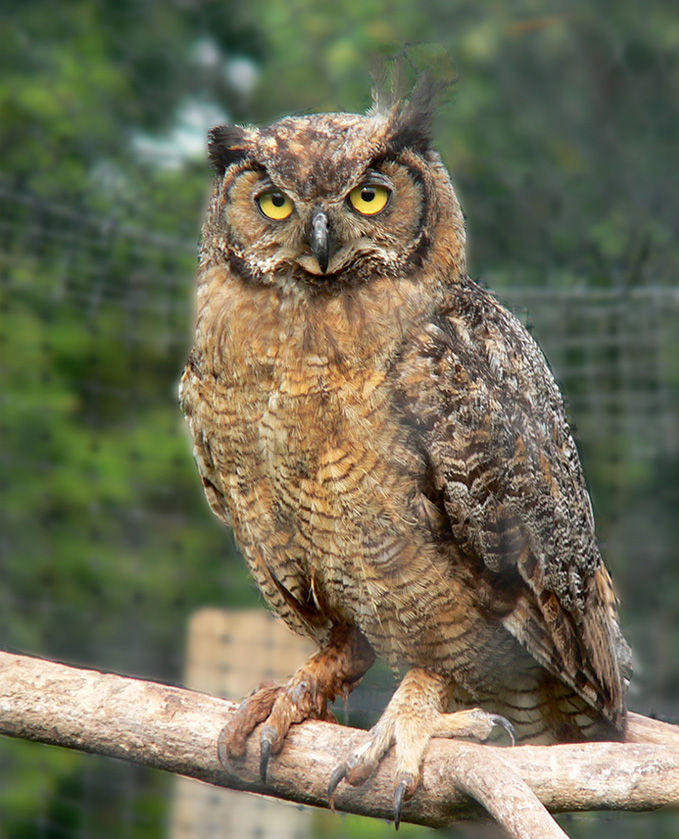
By John Shackford
The Great Horned Owl (Bubo virginianus) ranges from most of Alaska and the southern two-thirds of Canada all the way down to the southern tip of South America. In Oklahoma, according to Sutton (1967, Oklahoma Birds) it is “[l]argly non-migratory, but some shifting of populations probably takes place in winter.” Sutton gives two examples of possible shifting, one of a nestling banded in Woods County (northwest Oklahoma) in April, 1953, and recovered in McClain County (central Oklahoma) in November 1958, and another banded as a nestling in Woods County in May 1956 and recovered in January 1958 in Barber County, south-central Kansas. The size of winter territories usually has a radius of about one-fourth mile, slightly larger in breeding season according to J.J. Craighhead and F.C. Craighead, Jr. (1969. Hawks, Owls and Wildlife).
The Great Horned Owl and the Red-tailed Hawk have a broad and quite similar prey base, the owl hunting primarily at night and the Red-tail during the day. But people who have reared Great Horned Owls in captivity have been able to determine that the owl has excellent eyesight during the day, as well as at night. And the owl sometimes will hunt during the day, especially when raising young. The Great Horned and the Red-tailed Hawk sometimes will also nest quite close together without any signs of conflict.
The Great Horned prey base is primarily small mammals, but it will also take some birds, snakes, even frogs and crawfish. Near one nest found in Norman, Oklahoma, there were remains of meadowlark, duck, American Coot, and Greater Yellowleg, as well as a cottontail rabbit. In most areas its favorite prey item is rabbits. This prey item shows up quite frequently when the owls are raising young: often the back halves of rabbits will be at the nest. I suspect it is snacks for the kids! It is also known to prey on skunks a fact confirmed when the adults and nest smell of skunk scent. It is known to fly at and strike a squirrel’s nest to flush squirrels into the open; to catch domestic cats; and to feed on bats exiting bat caves. It usually has a regular feeding perch, most often not far from its nest.
The Great Horned Owl is one of the earliest of nesters in Oklahoma, Sutton giving the earliest nesting date as 6 February 1955 in Marshall County (south-central Oklahoma). There is a live webcam of a nesting Great Horned in Oklahoma. This owl nesting site has been livestreamed for the last five years, the site started by a young girl named Alessondra. The nest is in a flower planter located on a second floor balcony of a home in Oklahoma City and this owl cam has had over 7.5 million visits from around the world.
The Great Horned Owl nests in a diversity of places, old eagle, hawk or crow nests, old squirrel nests, infrequently in hollow trees, cliffs, even on the ground. Clutch size varies from one to five, but is most often limited to two eggs.
The Great Horned differs from the Barred Owl in a number of ways. Of course there is a very distinct difference in their calls. The Great Horned has yellow eyes and conspicuous “horns,” while the Barred has dark eyes and a round face a round face and head, and the Great Horned has horizontal stripes on the breast, while the Barred has vertical stripes below the upper breast. The Great Horned is larger (23 inches) than the Barred (21 inches).
Once on an Oklahoma City Christmas Bird Count, I was at the Stinchcomb Wildlife Preserve at Lake Overholser. It was early morning and just starting to get light. I had squeaked for owls for maybe four or five minutes and was resting my squeaker. I had about given up on getting any owl to respond. Just before leaving, however, a large owl flew straight at my head. I threw my arms up to ward off getting hit in the head, or another possibility, my head becoming an owl perch. Fortunately about three feet from my head the owl flared away. My recollection is that I identified it as a Great Horned Owl, rather than a Barred Owl, but I do not recall the exact basis of my identification. Similar episodes have been reported in the literature on occasion: someone wearing a fur hat has been attacked by a Great Horned Owl because the owl thought the hat was a prey item!
